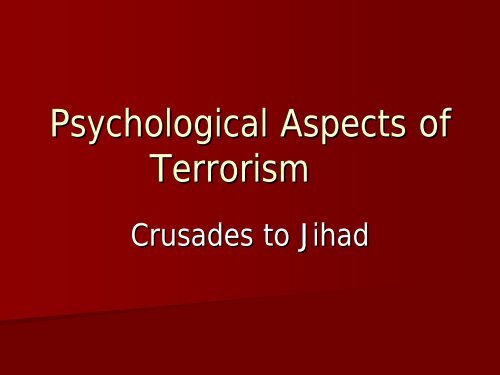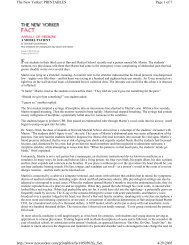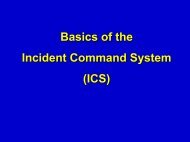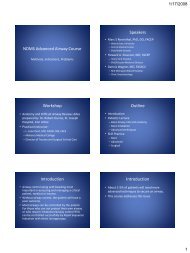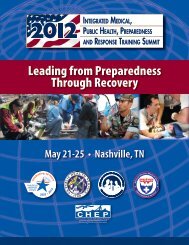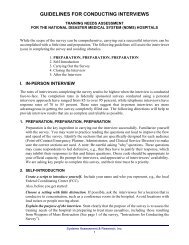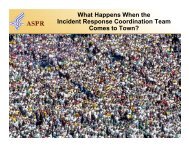Psychology of Terrorism
Psychology of Terrorism
Psychology of Terrorism
You also want an ePaper? Increase the reach of your titles
YUMPU automatically turns print PDFs into web optimized ePapers that Google loves.
Psychological Aspects <strong>of</strong><br />
<strong>Terrorism</strong><br />
Crusades to Jihad
Patrick F. DeMarco, Ph.D., B.C.E.T.S.,<br />
F.A.A.E.T.S., KCStS.<br />
Colorado Mountain Psychological Services<br />
Fort Collins, Colorado
PROLOGUE<br />
<strong>Terrorism</strong> is not a new concept. The history<br />
<strong>of</strong> terrorism goes back as far as recorded<br />
history. This presentation cannot cover all<br />
aspects <strong>of</strong> terrorism nor its history in its<br />
entirety. The purpose <strong>of</strong> this presentation<br />
to provide a brief overview <strong>of</strong> terrorism<br />
from the Crusades and the current Jihads.<br />
This presentation will explore the<br />
psychological principles necessary to<br />
create terrorism.
For the purpose <strong>of</strong> this presentation,<br />
religious based terrorism will be the focus.<br />
This is not meant to be a definitive<br />
position but rather a starting point <strong>of</strong><br />
understand the psychological aspects that<br />
are “played-out” in the engagement <strong>of</strong><br />
terrorist tactics.
TABLE OF CONTENTS<br />
I. The Types <strong>of</strong> <strong>Terrorism</strong><br />
II.<br />
III.<br />
IV.<br />
The Crusades<br />
The Jihads<br />
The Philosophy <strong>of</strong> <strong>Terrorism</strong><br />
V. Psychological Components <strong>of</strong> <strong>Terrorism</strong><br />
VI.<br />
Making the Psychological Components<br />
<strong>of</strong> <strong>Terrorism</strong> Work
The Four Types <strong>of</strong> <strong>Terrorism</strong><br />
1. Political<br />
2. Ethnic<br />
3. Religious<br />
4. Monetary
Political<br />
This is the act <strong>of</strong> terrorism that is intended<br />
to bring about a political change: e.g., the<br />
conflict in Northern Ireland (religious<br />
issues are also a part <strong>of</strong> that conflict:<br />
Catholics vs. Protestants)- Catholics<br />
representing the Native Irish and the<br />
Protestants representing the Cromwellian<br />
Irish.
Ethnic<br />
This is terrorism directed against a group <strong>of</strong><br />
people who are ethnically and/or racially<br />
different. This type <strong>of</strong> terrorism is <strong>of</strong>ten<br />
directed with genocide intent.
Religious<br />
This is terrorism directed by religious fervor<br />
and is intent on destroying the opposing<br />
faction or belief system.
Monetary<br />
This form <strong>of</strong> terrorism is designed to bring<br />
about monetary gain and/or the loss <strong>of</strong> a<br />
rival individual, family, group, or nation by<br />
depleting their financial resources.
THE CRUSADES<br />
One <strong>of</strong> the most enduring though least-discussed results <strong>of</strong> the<br />
Crusades was the development <strong>of</strong> the word crusade (which first<br />
appeared in its Latin form in the late 12th or early 13th century) to<br />
denote any common endeavour in a worthy cause. The<br />
transformation <strong>of</strong> the idea <strong>of</strong> the Crusades from religio-military<br />
campaigns into modern metaphors for idealistic, zealous, and<br />
demanding struggles to advance the good (“crusades(<br />
for”) ) and to<br />
oppose perceived evil (“crusades(<br />
against”) ) occurred over several<br />
centuries and represents the culmination <strong>of</strong> a movement that began<br />
in the late 11th century. By the early 12th century, historiography<br />
was already contributing to the idea <strong>of</strong> Crusade as armed pilgrimage<br />
or holy war, which Bernard <strong>of</strong> Clairvaux in the mid-12th century and<br />
Pope Innocent III in the early 13th continued to elaborate.<br />
Receptive to chivalric as well as Christian ideals, Crusade ideology<br />
proved more durable than the stinging criticisms provoked by<br />
successive military defeats, culminating in the loss <strong>of</strong> the Holy Land<br />
in 1291.
By the middle <strong>of</strong> the 12th century, control <strong>of</strong><br />
Jerusalem and the Holy Land was no longer the<br />
only goal <strong>of</strong> the Crusades. Rather, Crusading<br />
became a special class <strong>of</strong> war called by the pope<br />
against the enemies <strong>of</strong> the faith, who were by<br />
no means confined to the Levant. Crusades<br />
continued in the Baltic region against pagans<br />
and in Spain against Muslims. Yet in the heart <strong>of</strong><br />
Europe a more serious threat faced<br />
Christendom—heresy<br />
heresy. . In the medieval world,<br />
heresy did not represent benign religious<br />
diversity but was seen as a cancerous threat to<br />
the salvation <strong>of</strong> souls. It was held to be even<br />
more dangerous than the faraway Muslims,<br />
because it harmed the body <strong>of</strong> Christ from<br />
within.
The most vibrant heresy in Europe was<br />
Catharism, , also known as Albigensianism for<br />
the Albi, a city in southern France where it<br />
flourished. A dualist belief, Catharism held that<br />
the universe was a battleground between good,<br />
which was spirit, , and evil, which was matter.<br />
Human beings were believed to be spirits<br />
trapped in physical bodies. The leaders <strong>of</strong> the<br />
religion, , the perfects, lived with great austerity,<br />
remaining chaste and avoiding all foods that<br />
came from sexual union.
The church had attempted for years to root out the heresy<br />
from southern France, where it remained popular,<br />
particularly among the nobility. St. Dominic, , who was<br />
sent to the region to preach to the people and debate<br />
the Cathar leaders, formed his Order <strong>of</strong> Preachers<br />
(Dominicans)) in response to the heresy. All efforts at<br />
eradication failed, however, largely because <strong>of</strong> the<br />
tolerance <strong>of</strong> the Cathari maintained by Raymond VI <strong>of</strong><br />
Toulouse, the greatest baron <strong>of</strong> the area, and by most<br />
secular lords in the region. Shortly after his<br />
excommunication for abetting the heretics, Raymond<br />
was implicated in the murder <strong>of</strong> a papal legate sent to<br />
investigate the situation. For Pope Innocent III that was<br />
the final straw. In March 1208 he called for a Crusade<br />
against Raymond and the heretics <strong>of</strong> Languedoc, which<br />
began the following year.
CRUSADES!<br />
On July 22, 1209. the Feast Day <strong>of</strong> St. Mary<br />
Magdalene in the town <strong>of</strong> Beziers in the<br />
Languedoc <strong>of</strong> France the Albigensian<br />
Crusade (between the 4 th and 5 th Crusade)<br />
terror in the name <strong>of</strong> religion gave rise to<br />
an expression heard today.
The town was refuge to 222 Cathars, which<br />
were about 10% <strong>of</strong> the town’s s population.<br />
The French Crusading Army under the Papal<br />
Legate- Arnold Amaury was preparing to<br />
attack. His generals asked how they<br />
would recognize the Cathars from the<br />
general population and Amaury is quoted<br />
to have said- ‘Kill them all. God will<br />
recognize his own.’
In the ensuing bloodbath between 15,000<br />
and 20,000 innocent people were<br />
butchered. Rivers <strong>of</strong> blood coursed<br />
through the streets <strong>of</strong> Beziers. The terror<br />
escalated following the fall <strong>of</strong> Beziers. A<br />
‘Crusader’ named Simon de Montfort<br />
emerged as a leader for Amaury. In the<br />
Campaign <strong>of</strong> 1210 he had taken the town<br />
<strong>of</strong> Bram after a 3 day siege. <strong>Terrorism</strong><br />
was to take a new turn.
Simon ordered a forced march <strong>of</strong> 100 <strong>of</strong><br />
Bram’s s defenders to the next town some<br />
20 miles away. Before setting <strong>of</strong>f he<br />
ordered that they would be blinded, have<br />
their noses and upper lips cut <strong>of</strong>f. The<br />
man at the head <strong>of</strong> the procession was left<br />
1 eye so he could see and he led them on<br />
the march. <strong>Terrorism</strong> would have it’s<br />
affect and towns would capitulate to him.<br />
Simon continued his terrorism throughout<br />
the ‘Crusade. Crusade.’
An interesting side note to Simon de<br />
Montfort is that his son would become a<br />
major figure in England’s s history and is<br />
<strong>of</strong>ten credited with being an initial leading<br />
force in bring Representative Government<br />
to England. He was killed by King Edward<br />
I.
The Albigensian Crusade dragged on for several<br />
years, with new recruits arriving each spring to<br />
assist Simon. By the end <strong>of</strong> the summer,<br />
however, they would all return home, leaving<br />
him with a skeleton force to defend his gains. By<br />
1215, when the fourth Lateran Council met to<br />
consider the state <strong>of</strong> the church, Simon had<br />
captured most <strong>of</strong> the region, including Toulouse.<br />
The council gave the lands to Simon and then<br />
rescinded the Crusade indulgence for the war so<br />
that a new Crusade to the East could be<br />
organized.
For all <strong>of</strong> its violence and destruction, the<br />
Albigensian Crusade failed to remove the<br />
Cathar heresy from Languedoc. It did,<br />
however, provide a solid framework <strong>of</strong><br />
new secular lords willing to work with the<br />
church against the heretics. Through the<br />
subsequent efforts <strong>of</strong> the Dominican<br />
inquisitors, Catharism was virtually<br />
eliminated in Languedoc within a century.
"For medieval men and women, the Crusade was an act <strong>of</strong><br />
piety, charity, and love, but it was also a means <strong>of</strong><br />
defending their world, their culture, and their way <strong>of</strong><br />
life."<br />
It was to recover the Holy Land from Muslims. And later,<br />
with the rise <strong>of</strong> the Ottoman Turks, "crusades were no<br />
longer wars to expand Christendom but desperate<br />
attempts to slow the advance <strong>of</strong> Islam. Crusading had<br />
become a matter <strong>of</strong> simple survival."<br />
But that simple reasoning is reasoning that many<br />
"scholars" have demeaned. They point to Europe's<br />
burgeoning population, decide they needed more land,<br />
and recast the Crusades as colonialism.
The current war in Iraq and Afghanistan has<br />
been referred to as “The 10th Crusade” by<br />
some individuals.
JIHAD<br />
The term "Jihad" used without any qualifiers is<br />
generally understood to be referring to war on<br />
behalf <strong>of</strong> Islam. In broader usage and<br />
interpretation, the term has accrued both violent<br />
and non-violent meanings. It can imply striving<br />
to live a moral and virtuous life, spreading and<br />
defending Islam as well as fighting injustice and<br />
oppression, among other things. The relative<br />
importance <strong>of</strong> these two forms <strong>of</strong> jihad is a<br />
matter <strong>of</strong> controversy.
• Muslim scholars explained there are five kinds <strong>of</strong> jihad fi sabilillah<br />
(struggle in the cause <strong>of</strong> God):<br />
• Jihad <strong>of</strong> the heart/soul (jihad bil qalb/nafs) is an inner struggle<br />
<strong>of</strong> good against evil in the mind, through concepts such as tawhid.<br />
• Jihad by the tongue (jihad bil lisan) is a struggle <strong>of</strong> good against<br />
evil waged by writing and speech, such as in the form <strong>of</strong> dawah<br />
(proselytizing), Khutbas (sermons), etc.<br />
• Jihad by the pen and knowledge (jihad bil qalam/lim) is a<br />
struggle for good against evil through scholarly study <strong>of</strong> Islam,<br />
ijtihad (legal reasoning), and through sciences.<br />
• Jihad by the hand (jihad bil yad) refers to a struggle <strong>of</strong> good<br />
against evil waged by actions or with one's wealth, such as going g on<br />
the Hajj pilgrimage (seen as the best jihad for women), taking care<br />
<strong>of</strong> elderly parents, or political activity for furthering the cause <strong>of</strong><br />
Islam.<br />
• Jihad by the sword (jihad bis saif) refers to qital fi sabilillah<br />
(armed fighting in the way <strong>of</strong> God, or holy war), the most common<br />
usage by Salafi Muslims and <strong>of</strong>fshoots <strong>of</strong> the Muslim Brotherhood.
• Jihad Against Jews and Crusaders<br />
• World Islamic Front Statement<br />
• 23 February 1998<br />
• Shaykh Usamah Bin-Muhammad Bin-Ladin<br />
Ayman al-Zawahiri, amir <strong>of</strong> the Jihad Group in Egypt<br />
Abu-Yasir Rifa'i Ahmad Taha, Egyptian Islamic Group<br />
Shaykh Mir Hamzah, secretary <strong>of</strong> the Jamiat-ul<br />
ul-Ulema-e-Pakistan<br />
Fazlur Rahman, amir <strong>of</strong> the Jihad Movement in Bangladesh<br />
• Praise be to Allah, who revealed the Book, controls the clouds,<br />
defeats factionalism, and says in His Book: "But when the forbidden<br />
den<br />
months are past, then fight and slay the pagans wherever ye find<br />
them, seize them, beleaguer them, and lie in wait for them in every<br />
ery<br />
stratagem (<strong>of</strong> war)"; and peace be upon our Prophet, Muhammad<br />
Bin-'Abdallah, who said: I have been sent with the sword between<br />
my hands to ensure that no one but Allah is worshipped, Allah who<br />
put my livelihood under the shadow <strong>of</strong> my spear and who inflicts<br />
humiliation and scorn on those who disobey my orders.
• The Arabian Peninsula has never -- since Allah made it flat, created<br />
its desert, and encircled it with seas -- been stormed by any forces<br />
like the crusader armies spreading in it like locusts, eating its s riches<br />
and wiping out its plantations. All this is happening at a time in<br />
which nations are attacking Muslims like people fighting over a plate<br />
<strong>of</strong> food. In the light <strong>of</strong> the grave situation and the lack <strong>of</strong> support,<br />
port,<br />
we and you are obliged to discuss current events, and we should all<br />
agree on how to settle the matter.<br />
• No one argues today about three facts that are known to everyone;<br />
we will list them, in order to remind everyone:<br />
• First, for over seven years the United States has been occupying the<br />
lands <strong>of</strong> Islam in the holiest <strong>of</strong> places, the Arabian Peninsula,<br />
plundering its riches, dictating to its rulers, humiliating its people,<br />
terrorizing its neighbors, and turning its bases in the Peninsula a into<br />
a spearhead through which to fight the neighboring Muslim peoples.<br />
• If some people have in the past argued about the fact <strong>of</strong> the<br />
occupation, all the people <strong>of</strong> the Peninsula have now acknowledged<br />
it. The best pro<strong>of</strong> <strong>of</strong> this is the Americans' continuing aggression<br />
against the Iraqi people using the Peninsula as a staging post, even<br />
though all its rulers are against their territories being used to that<br />
end, but they are helpless.
• Second, despite the great devastation inflicted on the Iraqi people<br />
ple<br />
by the crusader-Zionist alliance, and despite the huge number <strong>of</strong><br />
those killed, which has exceeded 1 million... despite all this, the<br />
Americans are once against trying to repeat the horrific massacres,<br />
as though they are not content with the protracted blockade<br />
imposed after the ferocious war or the fragmentation and<br />
devastation.<br />
• So here they come to annihilate what is left <strong>of</strong> this people and to<br />
humiliate their Muslim neighbors.<br />
• Third, if the Americans' aims behind these wars are religious and<br />
economic, the aim is also to serve the Jews' petty state and divert<br />
attention from its occupation <strong>of</strong> Jerusalem and murder <strong>of</strong> Muslims<br />
there. The best pro<strong>of</strong> <strong>of</strong> this is their eagerness to destroy Iraq, , the<br />
strongest neighboring Arab state, and their endeavor to fragment all<br />
the states <strong>of</strong> the region such as Iraq, Saudi Arabia, Egypt, and<br />
Sudan into paper statelets and through their disunion and weakness<br />
to guarantee Israel's survival and the continuation <strong>of</strong> the brutal<br />
crusade occupation <strong>of</strong> the Peninsula.
• All these crimes and sins committed by the Americans are a clear declaration <strong>of</strong> war<br />
on Allah, his messenger, and Muslims. And ulema have throughout Islamic history<br />
unanimously agreed that the jihad is an individual duty if the enemy e<br />
destroys the<br />
Muslim countries. This was revealed by Imam Bin-Qadamah in "Al- Mughni," Imam<br />
al-Kisa'i in "Al-Bada'i," al-Qurtubi in his interpretation, and the shaykh <strong>of</strong> al-Islam in<br />
his books, where he said: "As for the fighting to repulse [an enemy], emy], it is aimed at<br />
defending sanctity and religion, and it is a duty as agreed [by the ulema]. Nothing is<br />
more sacred than belief except repulsing an enemy who is attacking religion and life."<br />
• On that basis, and in compliance with Allah's order, we issue the e following fatwa to<br />
all Muslims:<br />
• The ruling to kill the Americans and their allies -- civilians and military -- is an<br />
individual duty for every Muslim who can do it in any country in which it is possible to<br />
do it, in order to liberate the al-Aqsa Mosque and the holy mosque [Mecca] from<br />
their grip, and in order for their armies to move out <strong>of</strong> all the lands <strong>of</strong> Islam,<br />
defeated and unable to threaten any Muslim. This is in accordance e with the words <strong>of</strong><br />
Almighty Allah, "and fight the pagans all together as they fight you all together," and<br />
"fight them until there is no more tumult or oppression, and there prevail justice and<br />
faith in Allah."<br />
• This is in addition to the words <strong>of</strong> Almighty Allah: "And why should ye not fight in the<br />
cause <strong>of</strong> Allah and <strong>of</strong> those who, being weak, are ill-treated (and oppressed) --<br />
women and children, whose cry is: 'Our Lord, rescue us from this town, whose<br />
people are oppressors; and raise for us from thee one who will help!'" h
• We -- with Allah's help -- call on every Muslim who believes in Allah<br />
and wishes to be rewarded to comply with Allah's order to kill the t<br />
Americans and plunder their money wherever and whenever they<br />
find it. We also call on Muslim ulema, leaders, youths, and soldiers<br />
to launch the raid on Satan's U.S. troops and the devil's supporters<br />
allying with them, and to displace those who are behind them so<br />
that they may learn a lesson.<br />
• Almighty Allah said: "O ye who believe, give your response to Allah<br />
lah<br />
and His Apostle, when He calleth you to that which will give you life.<br />
And know that Allah cometh between a man and his heart, and that<br />
it is He to whom ye shall all be gathered."<br />
• Almighty Allah also says: "O ye who believe, what is the matter with<br />
you, that when ye are asked to go forth in the cause <strong>of</strong> Allah, ye y<br />
cling so heavily to the earth! Do ye prefer the life <strong>of</strong> this world to<br />
the hereafter But little is the comfort <strong>of</strong> this life, as compared with<br />
the hereafter. Unless ye go forth, He will punish you with a grievous<br />
penalty, and put others in your place; but Him ye would not harm in<br />
the least. For Allah hath power over all things."<br />
• Almighty Allah also says: "So lose no heart, nor fall into despair. For<br />
ye must gain mastery if ye are true in faith."
Quotes from Osama bin Laden:<br />
• "We should fully understand our religion.<br />
Fighting is a part <strong>of</strong> our religion and our Sharia<br />
[an Islamic legal code]. Those who love God and<br />
his Prophet and this religion cannot deny that.<br />
Whoever denies even a minor tenet <strong>of</strong> our<br />
religion commits the gravest sin in Islam."<br />
• "Hostility toward America is a religious duty, and<br />
we hope to be rewarded for it by God . . . . I am<br />
confident that Muslims will be able to end the<br />
legend <strong>of</strong> the so-called superpower that is<br />
America. Time Magazine
• "The pieces <strong>of</strong> the bodies <strong>of</strong> infidels were flying<br />
like dust particles. If you would have seen it<br />
with your own eyes, you would have been very<br />
pleased, and your heart would have been filled<br />
with joy." -- At the wedding <strong>of</strong> his son in<br />
southern Kandahar about the 17 sailors who<br />
died suicide bombing <strong>of</strong> the USS Cole <strong>of</strong>f the<br />
coast <strong>of</strong> Yemen<br />
• "Every American man is an enemy to us." --<br />
Independent.<br />
• " . . . It is far better for anyone to kill a single<br />
American soldier than to squander his efforts on<br />
other activities." -- May 1998
"We--<br />
--with God's help--<br />
--call on every Muslim who<br />
believes in God and wishes to be rewarded to<br />
comply with God's order to kill the Americans<br />
and plunder their money wherever and<br />
whenever they find it. We also call on Muslim<br />
ulema, leaders, youths, and soldiers to launch<br />
the raid on Satan's U.S. troops and the devil's<br />
supporters allying with them, and to displace<br />
those who are behind them so that they may<br />
learn a lesson." Feb. 1998 - Bin Laden edict
• ``We are seeking to incite the (Islamic) nation<br />
to rise up to liberate its land and to (conduct)<br />
jihad (holy war) for the sake <strong>of</strong> God." -- al-<br />
Jazeera, June 1999.<br />
• "`I was never afraid <strong>of</strong> death ... As Muslims, we<br />
believe that when we die, we go to heaven.<br />
Before a battle, God sends us ... tranquility." --<br />
Independent, , 1993.<br />
• "I'm fighting so I can die a martyr and go to<br />
heaven to meet God. Our fight now is against<br />
the Americans." -- Osama bin Laden, quoted by<br />
Al-Quds<br />
Al-Arabi<br />
Arabi newspaper
• the Americans." -- Osama bin Laden, quoted by Al-Quds<br />
Al-Arabi<br />
Arabi newspaper<br />
• "We declared jihad against the US government, because<br />
the US government is unjust, criminal and tyrannical. It<br />
has committed acts that are extremely unjust, hideous<br />
and criminal whether directly or through its support <strong>of</strong><br />
the Israeli occupation." - Osama bin Laden - to CNN in<br />
March 1997<br />
• " . . . For the American forces to expect anything from<br />
me personally reflects a very narrow perception.<br />
Thousands <strong>of</strong> millions <strong>of</strong> Muslims are angry. The<br />
Americans should expect reactions from the Muslim<br />
world that are proportionate to the injustice they inflict."<br />
to Time Magazine Dec 1998
• Responding to the question "are you trying<br />
to acquire chemical and nuclear weapons"<br />
• "Acquiring weapons for the defense <strong>of</strong> Muslims<br />
is a religious duty. If I have indeed acquired<br />
these weapons, then I thank God for enabling<br />
me to do so. And if I seek to acquire these<br />
weapons, I am carrying out a duty. It would be<br />
a sin for Muslims not to try to possess the<br />
weapons that would prevent the infidels from<br />
inflicting harm on Muslims." Time Magazine Dec<br />
1998
Usama bin Ladin inherited $300 million dollars<br />
from his family when his father died. He uses<br />
this money to finance the group. Al-Qaeda also<br />
takes in money from the donations <strong>of</strong> rich<br />
middle eastern men who believe in what Al-<br />
Qaeda does. Several fake charities also solicit<br />
money from people who do not know what the<br />
money is used for. Everyone who buys and uses<br />
illegal drugs are most likely buying them from a<br />
terrorist group, and are supporting terrorism by<br />
buying drugs. Al-Qaeda has extended their<br />
friendship with Sunni extremist groups which<br />
gives them an even larger network to use in<br />
planning attacks.
THE PHILOSOPHY OF TERRORISM<br />
This is a brief overview <strong>of</strong> the philosophy <strong>of</strong><br />
terrorism as proposed by Ernesto “Che”<br />
Guevera.
Guerrilla warfare, the basis <strong>of</strong> the struggle <strong>of</strong> a<br />
people to redeem itself, has diverse<br />
characteristics, different facets, even though the<br />
essential will for liberation remains the same. It<br />
is obvious-and writers on the theme have said it<br />
many times-that that war responds to a certain series<br />
<strong>of</strong> scientific laws; whoever ignores them will go<br />
down to defeat. Guerrilla warfare as a phase <strong>of</strong><br />
war must be ruled by all <strong>of</strong> these; but besides,<br />
because <strong>of</strong> its special aspects, a series <strong>of</strong><br />
corollary laws must also be recognized in order<br />
to carry it forward. Though geographical and<br />
social conditions in each country determine the<br />
mode and particular forms that guerrilla warfare<br />
will take, there are general laws that hold for all<br />
fighting <strong>of</strong> this type.
• Naturally, it is not to be thought that all conditions for<br />
revolution are going to be created through the impulse<br />
given to them by guerrilla activity. It must always be<br />
kept in mind that there is a necessary minimum without<br />
which the establishment and consolidation <strong>of</strong> the first<br />
center is not practicable. People must see clearly the<br />
futility <strong>of</strong> maintaining the fight for social goals within the<br />
framework <strong>of</strong> civil debate. When the forces <strong>of</strong> oppression<br />
come to maintain themselves in power against<br />
established law, peace is considered already broken.<br />
• In these conditions popular discontent expresses itself in<br />
more active forms. An attitude <strong>of</strong> resistance finally<br />
crystallizes in an outbreak <strong>of</strong> fighting, provoked initially<br />
by the conduct <strong>of</strong> the authorities.
Let us first consider the question: Who are the combatants<br />
in guerrilla warfare On one side we have a group<br />
composed <strong>of</strong> the oppressor and his agents, the<br />
pr<strong>of</strong>essional army, well armed and disciplined, in many<br />
cases receiving foreign help as well as the help <strong>of</strong> the<br />
bureaucracy in the employ <strong>of</strong> the oppressor. On the<br />
other side are the people <strong>of</strong> the nation or region<br />
involved. It is important to emphasize that guerrilla<br />
warfare is a war <strong>of</strong> the masses, a war <strong>of</strong> the people. The<br />
guerrilla band is an armed nucleus, the fighting<br />
vanguard <strong>of</strong> the people. It draws its great force from the<br />
mass <strong>of</strong> the people themselves. The guerrilla band is not<br />
to be considered inferior to the army against which it<br />
fights simply because it is inferior in firepower. Guerrilla<br />
warfare is used by the side which is supported by a<br />
majority but which possesses a much smaller number <strong>of</strong><br />
arms for use in defense against oppression.
The guerrilla fighter needs full help from the<br />
people <strong>of</strong> the area. This is an indispensable<br />
condition. This is clearly seen by considering the<br />
case <strong>of</strong> bandit gangs that operate in a region.<br />
They have all the characteristics <strong>of</strong> a guerrilla<br />
army: homogeneity, respect for the leader,<br />
valor, knowledge <strong>of</strong> the ground, and, <strong>of</strong>ten,<br />
even good understanding <strong>of</strong> the tactics to be<br />
employed. The only thing missing is support <strong>of</strong><br />
the people; and, inevitably, these gangs are<br />
captured and exterminated by the public force.
Analyzing the mode <strong>of</strong> operation <strong>of</strong> the guerrilla band,<br />
seeing its form <strong>of</strong> struggle, and understanding its base in<br />
the masses, we can answer the question: Why does the<br />
guerrilla fighter fight We must come to the inevitable<br />
conclusion that the guerrilla fighter is a social reformer,<br />
that he takes up arms responding to the angry protest <strong>of</strong><br />
the people against their oppressors, and that he fights in<br />
order to change the social system that keeps all his<br />
unarmed brothers in ignominy and misery. He launches<br />
himself against the conditions <strong>of</strong> the reigning institutions<br />
at a particular moment and dedicates himself with all the<br />
vigor that circumstances permit to breaking the mold <strong>of</strong><br />
these institutions.
The term "terrorism" means premeditated,<br />
politically motivated violence perpetrated<br />
against noncombatant targets by<br />
subnational groups or clandestine agents,<br />
usually intended to influence an audience.
• The term "international terrorism" means<br />
terrorism involving citizens or the territory<br />
<strong>of</strong> more than one country.<br />
• The term "terrorist group" means any<br />
group practicing, or that has significant<br />
subgroups that practice, international<br />
terrorism.
• In December 1998 the Abu Nidal Organization<br />
moved to Iraq. It also has refugee camps and a<br />
base to operate from in Lebanon. There are<br />
some bases in Sudan and Syria. This terrorist<br />
group operates easily around the world, but<br />
especially in the Middle East, Asia, and Europe.<br />
• Up until 1987, the Abu Nidal Organization was<br />
given a lot <strong>of</strong> help from Iraq, Libya, and Syria.<br />
They received money, safe hiding places,<br />
training, and support when it was time to make<br />
an attack. In 1999 this group was forced out <strong>of</strong><br />
Libya and Egypt. No countries are supporting<br />
the Abu Nidal Organization right now.
• The Hezballa Terrorist organization operates<br />
from different locations around Lebanon; Bekaa<br />
Valley, southern areas <strong>of</strong> Beirut, and southern<br />
Lebanon. There are Hezballa terrorist cells in<br />
Europe, Africa, South America, North America,<br />
and Asia.<br />
• Party <strong>of</strong> God<br />
Islamic Jihad<br />
Revolutionary Justice Organization<br />
Organization <strong>of</strong> the Oppressed on Earth<br />
Islamic Jihad for the Liberation <strong>of</strong> Palestine
• In the 1980's the Iranian security forces<br />
expelled the leaders <strong>of</strong> the Mujahedin-e-<br />
Khalq Organization. They moved to<br />
France, but now have relocated to a base<br />
just across the border from Iran in the<br />
country <strong>of</strong> Iraq.<br />
• The National Liberation Army <strong>of</strong><br />
IranPeople's Mujahidin <strong>of</strong> IranNational<br />
Council <strong>of</strong> ResistanceMuslim Iranian<br />
Student's Society
In August 1999, the authorities <strong>of</strong> Jordanian<br />
shut down Hamas's Political Bureau <strong>of</strong>fices<br />
in Amman, arrested the groups leaders,<br />
and Jordanian didn't let them operate<br />
there any more.They are located in Israel.
• The Japanese Red Army is an international<br />
terrorist group that formed in 1970 after<br />
they broke away from the Japanese<br />
Communist League-Red Army Faction.<br />
Fusako Shigenobuled the JRA until she<br />
was arrested in November 2000 in Japan.<br />
Their historical goals are to help foment<br />
world revolution and to help foment world<br />
revolution.<br />
• Anti-Imperialist International Brigade
• Al-Jihad is an Egyptian Islamic group that<br />
has been active since the 1970s.They are<br />
close parteners with the terrorist<br />
organization al-Qaida. One <strong>of</strong> their goals is<br />
to attack the US by overthrowing the<br />
Egyptian Government and replacing it with<br />
an Islamic state.<br />
• Egyptian Islamic Jihad<br />
Jihad Group<br />
Islamic Jihad
PSYCHOLOGICAL COMPONENTS OF<br />
TERRORISM<br />
• Common characteristics <strong>of</strong> people with antisocial personality disorder include:<br />
• Persistent lying or stealing<br />
• Recurring difficulties with the law<br />
• Tendency to violate the rights and boundaries <strong>of</strong> others (property, physical, sexual, emotional,<br />
legal)<br />
• Substance abuse<br />
• Aggressive, <strong>of</strong>ten violent behavior; prone to getting involved in fights<br />
• A persistent agitated or depressed feeling (dysphoria(<br />
dysphoria)<br />
• Inability to tolerate boredom<br />
• Disregard for the safety <strong>of</strong> self or others<br />
• A childhood diagnosis <strong>of</strong> conduct disorders - this is not a symptom but "a history <strong>of</strong>"<br />
• Lack <strong>of</strong> remorse for hurting others<br />
• Superficial charm<br />
• Impulsiveness<br />
• A sense <strong>of</strong> extreme entitlement<br />
• Inability to make or keep friends<br />
• Lack <strong>of</strong> guilt<br />
• Relentlessness<br />
• Recklessness, impulsivity
• Diagnostic criteria<br />
• In addition to the above, three or more <strong>of</strong> the following is<br />
required:<br />
• failure to conform to social norms with respect to lawful behaviors<br />
as indicated by repeatedly performing acts that are grounds for<br />
arrest.<br />
• deceitfulness, as indicated by repeatedly lying, use <strong>of</strong> aliases, or<br />
conning others for personal pr<strong>of</strong>it or pleasure<br />
• impulsivity or failure to plan ahead<br />
• irritability and aggressiveness, as indicated by repeated physical<br />
fights or assaults<br />
• reckless disregard for safety <strong>of</strong> self or others<br />
• consistent irresponsibility, as indicated by repeated failure to<br />
sustain consistent work behavior or honor financial obligations<br />
• lack <strong>of</strong> remorse, as indicated by being indifferent to or<br />
rationalizing having hurt, mistreated, or stolen from another.
Antisocial personality disorder (APD)) is a<br />
mental disorder defined by the American<br />
Psychiatric Association's<br />
Diagnostic and<br />
Statistical Manual: : "The essential feature for the<br />
diagnosis is a pervasive pattern <strong>of</strong> disregard for,<br />
and violation <strong>of</strong>, the rights <strong>of</strong> others that begins<br />
in childhood or early adolescence and continues<br />
into adulthood." Considered essential features <strong>of</strong><br />
the disorder are deceit and manipulation.<br />
Therefore it is essential in making the diagnosis<br />
to collect material from sources other than the<br />
individual being diagnosed. Also, the individual<br />
must be age 18 or older as well as have a<br />
documented history <strong>of</strong> a conduct disorder before<br />
the age <strong>of</strong> 15.
Psychopathy is a psychological construct,<br />
classified by some as a personality<br />
disorder, , characterized by amoral and<br />
antisocial behavior. It is a term derived<br />
from the Greek psyche (soul, breath hence<br />
mind) ) and pathos (to suffer), and was<br />
once used to denote any form <strong>of</strong> mental<br />
illness, , <strong>of</strong>ten being confused with<br />
psychosis. . The term is <strong>of</strong>ten used<br />
interchangeably with sociopathy
Research into a group <strong>of</strong> individuals he<br />
described as psychopathic was first<br />
completed by Philippe Pinel almost 200<br />
years ago. Pinel described patients as<br />
"insane without delirium," which he<br />
characterized as a lack <strong>of</strong> restraint and<br />
remorselessness for their actions. Pinel felt<br />
that his patients were morally neutral,<br />
reflecting his humanistic approach to<br />
mental illness. The 19th century term<br />
used for such individuals was "moral<br />
imbecile"
The next most distinctive work on what were then<br />
called psychopaths was done in 1941 by Hervey<br />
Cleckley in his book The Mask <strong>of</strong> Sanity<br />
(significantly expanded in the second edition <strong>of</strong><br />
1950). Cleckley <strong>of</strong>fered a broad range <strong>of</strong> case<br />
histories, from all corners <strong>of</strong> society, all <strong>of</strong> which<br />
showed patients with the common characteristic<br />
<strong>of</strong> "emotional emptiness." Cleckley probed the<br />
psychopath's attitudes and thought patterns in<br />
search <strong>of</strong> a meaning for their unusual behaviour;<br />
however, according to Robert Hare, Cleckley's<br />
most important contribution was in providing the<br />
framework <strong>of</strong> emotion for most future research<br />
into this disorder.
• The seminal 20th century work on the subject is Hervey Cleckley's The<br />
Mask <strong>of</strong> Sanity first published in 1941. In The Mask <strong>of</strong> Sanity Cleckley<br />
introduced sixteen behavioral characteristics <strong>of</strong> a psychopath that he<br />
derived from clinical interviews and other corroborating sources.<br />
• Superficial charm and good "intelligence"<br />
• Absence <strong>of</strong> delusions and other signs <strong>of</strong> irrational thinking<br />
• Absence <strong>of</strong> "nervousness" or psychoneurotic manifestations<br />
• Unreliability<br />
• Untruthfulness and insincerity<br />
• Lack <strong>of</strong> remorse and shame<br />
• Inadequately motivated antisocial behavior<br />
• Poor judgment and failure to learn by experience<br />
• Pathologic egocentricity and incapacity for love<br />
• General poverty in major affective reactions<br />
• Specific loss <strong>of</strong> insight<br />
• Unresponsiveness in general interpersonal relations<br />
• Fantastic and uninviting behavior with drink and sometimes without<br />
• Suicide rarely carried out<br />
• Sex life impersonal, trivial, and poorly integrated<br />
• Failure to follow any life plan
Hare describes people he calls psychopaths<br />
as "intraspecies predators who use charm,<br />
manipulation, intimidation, , and violence to<br />
control others and to satisfy their own<br />
selfish needs. Lacking in conscience and in<br />
feelings for others, they take what they<br />
want and do as they please, violating<br />
social norms and expectations without<br />
guilt or remorse". "What is missing, in<br />
other words, are the very qualities that<br />
allow a human being to live in social<br />
harmony."
The prototypical psychopath has deficits or deviances in several areas:<br />
interpersonal relationships, emotion, and self-control. Psychopaths<br />
lack a sense <strong>of</strong> guilt or remorse for any harm they may have caused<br />
others, instead rationalizing the behavior, blaming someone else, , or<br />
denying it outright. Psychopaths also lack empathy towards others<br />
in general, resulting in tactlessness, insensitivity, and<br />
contemptuousness. All <strong>of</strong> this belies their tendency to make a good,<br />
od,<br />
likable first impression. Psychopaths have a superficial charm about a<br />
them, enabled by a willingness to say anything without concern for f<br />
accuracy or truth. This extends into their pathological lying and<br />
willingness to con and manipulate others for personal gain or<br />
amusement. The prototypical psychopath's emotions are described<br />
as a shallow affect, , meaning their overall way <strong>of</strong> relating is<br />
characterized by mere displays <strong>of</strong> friendliness and other emotion for<br />
personal gain; the displayed emotion need not correlate with felt<br />
emotion, in other words. Shallow affect also describes the<br />
psychopath's tendency for genuine emotion to be short lived and<br />
egocentric with an overall cold demeanor. Their behavior is<br />
impulsive and irresponsible, <strong>of</strong>ten failing to keep a job or defaulting<br />
on debts.
Psychopaths also have a markedly distorted<br />
sense <strong>of</strong> the potential consequences <strong>of</strong><br />
their actions, not only for others, but also<br />
for themselves. They do not, for example,<br />
deeply recognize the risk <strong>of</strong> being caught,<br />
disbelieved or injured as a result <strong>of</strong> their<br />
behaviour.
• Mealey uses the term "primary psychopathy" to differentiate<br />
between psychopathy that is biological in origin and "secondary<br />
psychopathy" that results from a combination <strong>of</strong> genetic and<br />
environmental influences. Lykken prefers sociopathy to describe the<br />
latter.<br />
• Sellbom and Ben-Porath (2005) describe the distinction succinctly:<br />
• Some people who engage in violent behavior possess psychopathic<br />
personality traits, such as callousness, grandiosity, and fearlessness,<br />
and presumably engage in such conduct because they care little<br />
about others. Others are impulsive and experience considerable<br />
anger, anxiety, and distress and may commit violent acts as a<br />
reaction to negative emotions, which are sometimes referred to as a<br />
"crimes <strong>of</strong> passion." Indeed, the distinction between primary and<br />
secondary psychopathy (including so-called neurotic psychopathy)<br />
has long been noted in the psychopathy literature (Karpman, 1947;<br />
Lykken, 1995).
• The difference between sociopathy and psychopathy, according to<br />
Hare, may "reflect the user's views on the origins and determinates<br />
tes<br />
<strong>of</strong> the disorder."<br />
• David T. Lykken proposes that psychopathy and sociopathy are two<br />
distinct kinds <strong>of</strong> antisocial personality. . He holds that psychopaths<br />
are born with temperamental differences such as impulsivity,<br />
cortical underarousal, and fearlessness that lead them to risk-<br />
seeking behavior and an inability to internalize social norms.<br />
Sociopaths, on the other hand, he believes to have relatively normal<br />
temperaments; their personality disorder being more an effect <strong>of</strong><br />
negative sociological factors like parental neglect, delinquent peers,<br />
poverty, , and extremely low or extremely high intelligence. Both<br />
personality disorders are, <strong>of</strong> course, the result <strong>of</strong> an interaction<br />
between genetic predispositions and environmental factors, but<br />
psychopathy leans towards the hereditary whereas sociopathy tends<br />
towards the environmental.
REINFORCEMENT<br />
In operant conditioning, reinforcement is an increase in<br />
the strength <strong>of</strong> a response following the change in<br />
environment immediately following that<br />
response.[citation needed] ] Response strength can be<br />
assessed by measures such as the frequency with which<br />
the response is made (for example, a pigeon may pecks<br />
a key more times in the session), or the speed with<br />
which it is made (for example, a rat may run a maze<br />
faster). The environment change which contingent upon<br />
the response is called a reinforcer. . Reinforcement can<br />
only be confirmed retrospectively, as objects, items, food<br />
or other potential 'reinforcers' can only be called such by<br />
demonstrating increases in behavior after their<br />
administration. It is the strength <strong>of</strong> the response that is<br />
reinforced, not the organism.
• Types <strong>of</strong> reinforcement<br />
• B.F. Skinner, , the researcher who articulated the major theoretical<br />
constructs <strong>of</strong> reinforcement and behaviorism, , refused to specify<br />
causal origins <strong>of</strong> reinforcers. Skinner argued that reinforcers are a<br />
defined by a change in response strength (that is, functionally<br />
rather than causally), and that what is a reinforcer to one person<br />
may not be to another. Accordingly, activities, foods or items which w<br />
are generally considered pleasant or enjoyable may not necessarily<br />
be reinforcing; they can only be considered so if the behavior that t<br />
immediately precedes the potential reinforcer increases in similar<br />
future situations. If a child receives a cookie when he or she asks a<br />
for one, and the frequency <strong>of</strong> 'cookie-requesting behavior' increases,<br />
the cookie can be seen as reinforcing 'cookie-requesting behavior'.<br />
If however, cookie-requesting behavior does not increase, the<br />
cookie cannot be considered reinforcing. The sole criterion which<br />
can determine if an item, activity or food is reinforcing is the change<br />
in the probability <strong>of</strong> a behavior after the administration <strong>of</strong> a<br />
potential reinforcer. Other theories may focus on additional factors<br />
such as whether the person expected the strategy to work at some<br />
point, but a behavioral theory <strong>of</strong> reinforcement would focus<br />
specifically upon the probability <strong>of</strong> the behavior.
• Positive reinforcement is an increase in the future<br />
frequency <strong>of</strong> a behavior due to the addition <strong>of</strong> a stimulus<br />
immediately following a response. Giving (or adding)<br />
food to a dog contingent on its sitting is an example <strong>of</strong><br />
positive reinforcement (if this results in an increase in<br />
the future behavior <strong>of</strong> the dog sitting).<br />
• Negative reinforcement is an increase in the future<br />
frequency <strong>of</strong> a behavior when the consequence is the<br />
removal <strong>of</strong> an aversive stimulus. Turning <strong>of</strong>f (or<br />
removing) ) an annoying song when a child asks their<br />
parent is an example <strong>of</strong> negative reinforcement (if this<br />
results in an increase in asking behavior <strong>of</strong> the child in<br />
the future).<br />
• Avoidance conditioning is a form <strong>of</strong> negative<br />
reinforcement that occurs when a behavior prevents an<br />
aversive stimulus from starting or being applied.
• Primary reinforcers<br />
• A primary reinforcer, sometimes called an unconditioned<br />
reinforcer, , is a stimulus that does not require pairing to function<br />
as a reinforcer and most likely has obtained this function through<br />
the evolution and its role in species' survival. Examples <strong>of</strong> primary<br />
reinforcers include sleep, food, air, water, and sex. Other primary<br />
reinforcers, such as certain drugs, may mimic the effects <strong>of</strong> other<br />
primary reinforcers. While these primary reinforcers are fairly<br />
stable through life and across individuals, the reinforcing value e <strong>of</strong><br />
different primary reinforcers varies due to multiple factors (e.g.,<br />
genetics, experience). Thus, one person may prefer one type <strong>of</strong><br />
food while another abhors it. Or one person may eat lots <strong>of</strong> food<br />
while another eats very little. So even though food is a primary<br />
reinforcer for both individuals, the value <strong>of</strong> food as a reinforcer<br />
er<br />
differs between them.<br />
• Often primary reinforcers shift their reinforcing value temporarily<br />
through satiation and deprivation. Food, for example, may cease<br />
to be effective as a reinforcer after a certain amount <strong>of</strong> it has been<br />
consumed (satiation). After a period during which it does not<br />
receive any <strong>of</strong> the primary reinforcer (deprivation), however, the<br />
primary reinforcer may once again regain its effectiveness in<br />
increasing response strength.
• Secondary reinforcers<br />
• A secondary reinforcer, , sometimes called a<br />
conditioned reinforcer, , is a stimulus or situation that has<br />
acquired its function as a reinforcer after pairing with a<br />
stimulus which functions as a reinforcer. This stimulus<br />
may be a primary reinforcer or another conditioned<br />
reinforcer (such as money). An example <strong>of</strong> a secondary<br />
reinforcer would be the sound from a clicker, as used in<br />
clicker training. . The sound <strong>of</strong> the clicker has been<br />
associated with praise or treats, and subsequently, the<br />
sound <strong>of</strong> the clicker may function as a reinforcer. As with<br />
primary reinforcers, an organism can experience<br />
satiation and deprivation with secondary reinforcers.
• Other reinforcement terms<br />
• A generalized reinforcer is a conditioned reinforcer that has been paired with<br />
many other reinforcers (such as money, a secondary generalized reinforcer). r<br />
• In reinforcer sampling a potentially reinforcing but unfamiliar stimulus is presented<br />
to an animal without regard to any prior behavior. The stimulus may then later be<br />
used more effectively in reinforcement.<br />
• Social reinforcement involves various sorts <strong>of</strong> access to and interaction with<br />
others.<br />
• Premack principle is a special case <strong>of</strong> reinforcement elaborated by David Premack,<br />
which states that a commonly occurring action can be used effectively as a reinforcer<br />
for a less commonly occurring one.<br />
• Reinforcement hierarchy is a list <strong>of</strong> actions, starting with the most desirable and<br />
ending with the least desirable. A reinforcement hierarchy can be be used to determine<br />
the relative frequency and desirability <strong>of</strong> different actions, and d is employed when<br />
applying the Premack principle.<br />
• Contingent outcomes are more likely to reinforce behavior than non-contingent<br />
responses. Contingent outcomes are those directly linked to a causal behavior, such a<br />
light turning on being contingent on flipping a switch. Note that t contingent outcomes<br />
are not necessary to demonstrate reinforcement, but perceived contingency cy may<br />
increase learning.<br />
• Contiguous responses are closely associated by time and space with specific<br />
behaviors, reduce the amount <strong>of</strong> time needed to learn a behavior while increasing its<br />
resistance to extinction. . Giving a dog a piece <strong>of</strong> food immediately after sitting is more<br />
contiguous with (and therefore more likely to reinforce) sitting behavior than giving<br />
the dog food several minutes after sitting.
• When an animal's surroundings are controlled, , its behavior patterns<br />
after reinforcement become predictable, even for very complex<br />
behavior patterns. A schedule <strong>of</strong> reinforcement is the protocol<br />
for determining when responses or behaviors will be reinforced,<br />
ranging from continuous reinforcement, in which every response is i<br />
reinforced, and extinction, , in which no response is reinforced.<br />
Between these extremes is intermittent or partial reinforcement<br />
where only some responses are reinforced.<br />
• Specific variations <strong>of</strong> intermittent reinforcement reliably induce<br />
specific patterns <strong>of</strong> response, irrespective <strong>of</strong> the species being<br />
investigated (including humans in some conditions). The orderliness<br />
ess<br />
and predictability <strong>of</strong> behaviour under schedules <strong>of</strong> reinforcement<br />
was evidence for B. F. Skinner's claim that using operant<br />
conditioning he could obtain "control over behaviour", in a way that<br />
rendered the theoretical disputes <strong>of</strong> contemporary comparative<br />
psychology obsolete. The reliability <strong>of</strong> schedule control supported<br />
the idea that a radical behaviourist experimental analysis <strong>of</strong><br />
behavior could be the foundation for a psychology that did not refer<br />
to mental or cognitive processes. The reliability <strong>of</strong> schedules also a<br />
led<br />
to the development <strong>of</strong> Applied Behavior Analysis as a means <strong>of</strong><br />
controlling or altering behavior.
• Simple schedules have a single rule to determine when a<br />
single type <strong>of</strong> reinforcer is delivered for specific<br />
response.<br />
• Fixed ratio (FR) schedules deliver reinforcement after<br />
every nth response<br />
– Example: FR2 = every second response is reinforced<br />
– Lab example: FR5 = rat reinforced with food after each 5 bar-<br />
presses in a Skinner box.<br />
– Real-world example: FR10 = Used car dealer gets a $1000<br />
bonus for each 10 cars sold on the lot.<br />
• Continuous ratio (CRF) schedules are a special form <strong>of</strong><br />
a fixed ratio. In a continuous ratio schedule,<br />
reinforcement follows each and every response.<br />
– Lab example: each time a rat presses a bar it gets a pellet <strong>of</strong><br />
food<br />
• Real world example: each time a dog defecates<br />
outside its owner gives it a treat
• Fixed interval (FI) schedules deliver reinforcement for the first<br />
response after a fixed length <strong>of</strong> time since the last reinforcement,<br />
nt,<br />
while premature responses are not reinforced.<br />
– Example: FI1" = reinforcement provided for the first response after 1<br />
second<br />
– Lab example: FI15" = rat is reinforced for the first bar press after 15<br />
seconds passes since the last reinforcement<br />
– Real world example: FI24 hour = calling a radio station is reinforced<br />
with a chance to win a prize, but the person can only sign up once per<br />
day<br />
• Variable ratio (VR) schedules deliver reinforcement after a random<br />
number <strong>of</strong> responses (based upon a predetermined average)<br />
– Example: VR3 = on average, every third response is reinforced<br />
– Lab example: VR10 = on average, a rat is reinforced for each 10 bar<br />
presses<br />
• Real world example: VR37 = a roulette player betting on specific<br />
numbers will win on average one every 37 tries (on a U.S. roulette<br />
te<br />
wheel, this would be VR38)
• Variable interval (VI) schedules deliver<br />
reinforcement for the first response after a<br />
random average length <strong>of</strong> time passes since the<br />
last reinforcement<br />
– Example: VI3" = reinforcement is provided for the<br />
first response after an average <strong>of</strong> 3 seconds since the<br />
last reinforcement.<br />
– Lab example: VI10" = a rat is reinforced for the first<br />
bar press after an average <strong>of</strong> 10 seconds passes since<br />
the last reinforcement<br />
• Real world example: a predator can expect to<br />
come across a prey on a variable interval<br />
schedule
• Other simple schedules include:<br />
• Differential reinforcement <strong>of</strong> incompatible behavior (DRI) is<br />
used to reduce a frequent behavior without punishing it by<br />
reinforcing an incompatible response. An example would be<br />
reinforcing clapping to reduce nose picking.<br />
• Differential reinforcement <strong>of</strong> other behavior (DRO) is used to<br />
reduce a frequent behavior by reinforcing any behavior other than<br />
the undesired one. An example would be reinforcing any hand<br />
action other than nose picking.<br />
• Differential reinforcement <strong>of</strong> low response rate (DRL) is used<br />
to encourage low rates <strong>of</strong> responding. It is like an interval schedule,<br />
except that premature responses reset the time required between<br />
behavior.<br />
– Lab example: DRL10" = a rat is reinforced for the first response after<br />
10 seconds, but if the rat responds earlier than 10 seconds there e is no<br />
reinforcement and the rat has to wait 10 seconds from that premature<br />
response without another response before bar pressing will lead to<br />
reinforcement.<br />
• Real world example: "If you ask me for a potato chip no more<br />
than once every 10 minutes, I will give it to you. If you ask more<br />
<strong>of</strong>ten, I will give you none."
• Differential reinforcement <strong>of</strong> high rate (DRH) is used to<br />
increase high rates <strong>of</strong> responding. It is like an interval schedule,<br />
except that a minimum number <strong>of</strong> responses are required in the<br />
interval in order to receive reinforcement.<br />
– Lab example: DRH10"/15 responses = a rat must press a bar 15<br />
times within a 10 second increment in order to be reinforced<br />
– Real world example: "If Lance Armstrong is going to win the Tour de<br />
France he has to peddle x number <strong>of</strong> times during the y hour race."<br />
• Fixed Time (FT) provides reinforcement at a fixed time since the<br />
last reinforcement, irrespective <strong>of</strong> whether the subject has<br />
responded or not. In other words, it is a non-contingent schedule.<br />
– Lab example: FT5": rat gets food every 5" regardless <strong>of</strong> the behavior.<br />
– Real world example: a person gets an annuity check every month<br />
regardless <strong>of</strong> behavior between checks<br />
• Variable Time (VT) provides reinforcement at an average variable<br />
time since last reinforcement, regardless <strong>of</strong> whether the subject has<br />
responded or not
• Effects <strong>of</strong> different types <strong>of</strong> simple schedules<br />
• Ratio schedules produce higher rates <strong>of</strong> responding than interval schedules, when the<br />
rates <strong>of</strong> reinforcement are otherwise similar.<br />
• Variable schedules produce higher rates and greater resistance to t extinction than<br />
most fixed schedules. This is also known as the Partial Reinforcement ement Extinction<br />
Effect (PREE)<br />
• The variable ratio schedule produces both the highest rate <strong>of</strong> responding sponding and the<br />
greatest resistance to extinction (an example would be the behavior <strong>of</strong> gamblers at<br />
slot machines)<br />
• Fixed schedules produce 'post-reinforcement pauses' (PRP), where responses will<br />
briefly cease immediately following reinforcement, though the pause is a function <strong>of</strong><br />
the upcoming response requirement rather than the prior reinforcement.<br />
ement.<br />
– The PRP <strong>of</strong> a fixed interval schedule is frequently followed by an accelerating rate <strong>of</strong><br />
response which is "scallop shaped," while those <strong>of</strong> fixed ratio schedules s<br />
are more angular.<br />
• Organisms whose schedules <strong>of</strong> reinforcement are 'thinned' (that is, i<br />
requiring more<br />
responses or a greater wait before reinforcement) may experience 'ratio strain' if<br />
thinned too quickly. This produces behavior similar to that seen during extinction.<br />
• Partial reinforcement schedules are more resistant to extinction than continuous<br />
reinforcement schedules.<br />
• Ratio schedules are more resistant than interval schedules and variable v<br />
schedules<br />
more resistant than fixed ones.
• Compound schedules combine two or more different simple<br />
schedules in some way using the same reinforcer for the same<br />
behaviour. There are many possibilities; among those most <strong>of</strong>ten<br />
used are:<br />
• Alternative schedules - A type <strong>of</strong> compound schedule where two<br />
or more simple schedules are in effect and which ever simple<br />
schedule is completed first results in reinforcement.<br />
• Conjunctive schedules - A complex schedule <strong>of</strong> reinforcement<br />
where two or more simple schedules are in effect independently <strong>of</strong> o<br />
each other and requirements on all <strong>of</strong> the simple schedules must be<br />
met for reinforcement.<br />
• Multiple schedules - either <strong>of</strong> two, or more, schedules may occur<br />
with a stimulus indicating which is in force.<br />
– Example: : FR4 when given a whistle and FI 6 when given a bell ring.<br />
• Mixed schedules - either <strong>of</strong> two, or more, schedules may occur<br />
with no stimulus indicating which is in force.<br />
• Example: : FI6 and then VR 3 without any stimulus warning <strong>of</strong> the<br />
change in schedule.
• Concurrent schedules - two schedules are simultaneously in force though not<br />
necessarily on two different response devices, and reinforcement on those schedules<br />
is independent <strong>of</strong> each other.<br />
• Interlocking Schedules - A single schedule with two components where progress<br />
in one component affects progress in the other component. An interlocking FR60-<br />
FI120, for example, each response subtracts time from the interval component such<br />
that each response is "equal" to removing two seconds from the FI. F<br />
• Chained schedules - reinforcement occurs after two or more successive schedules<br />
have been completed, with a stimulus indicating when one schedule e has been<br />
completed and the next has started.<br />
– Example: : FR10 in a green light when completed it goes to a yellow light to indicate FR 3,<br />
after it's completed it goes into red light to indicate VI 6, etc. At the end <strong>of</strong> the chain, a<br />
reinforcer is given.<br />
• Tandem schedules - reinforcement occurs when two or more successive schedule<br />
requirements have been completed, with no stimulus indicating when a schedule has<br />
been completed and the next has started.<br />
– Example: : VR 10, after it is completed the schedule is changed without warning w<br />
to FR 10,<br />
after that it is changed without warning to FR 16, etc. At the end e<br />
<strong>of</strong> the series <strong>of</strong> schedules,<br />
a reinforcer is finally given.<br />
• Higher order schedules - completion <strong>of</strong> one schedule is reinforced according to a<br />
second schedule; e.g. in FR2 (FI 10 secs), two successive fixed interval schedules<br />
would have to be completed before a response is reinforced.
• Shaping<br />
• Main article: Shaping (psychology)<br />
• Shaping involves reinforcing successive,<br />
increasingly accurate approximations <strong>of</strong> a<br />
response desired by a trainer. In training a rat<br />
to press a lever, for example, simply turning<br />
toward the lever will be reinforced at first. Then,<br />
only turning and stepping toward it will be<br />
reinforced. As training progresses, the response<br />
reinforced becomes progressively more like the<br />
desired behavior.
• Chaining<br />
• Main article: Chaining<br />
• Chaining involves linking discrete behaviors together in a series, such that<br />
each result <strong>of</strong> each behaviour is both the reinforcement (or consequence)<br />
for the previous behavior, and the stimuli (or antecedent) for the t<br />
next<br />
behavior. There are many ways to teach chaining, such as forward chaining<br />
(starting from the first behavior in the chain), backwards chaining ing (starting<br />
from the last behavior) and total task chaining (in which the entire behavior<br />
is taught from beginning to end, rather than as a series <strong>of</strong> steps). s). An<br />
example would be opening a locked door. First the key is inserted, then<br />
turned, then the door opened. Forward chaining would teach the subject s<br />
first to insert the key. Once that task is mastered, they are told to insert the<br />
key, and taught to turn it. Once that task is mastered, they are told to<br />
perform the first two, then taught to open the door. Backwards chaining c<br />
would involve the teacher first inserting and turning the key, and a<br />
the<br />
subject is taught to open the door. Once that is learned, the teacher inserts<br />
the key, and the subject is taught to turn it, then opens the door or as the<br />
next step. Finally, the subject is taught to insert the key, and they turn and<br />
open the door. Once the first step is mastered, the entire task has been<br />
taught. Total task chaining would involve teaching the entire task as a<br />
single series, prompting through all steps. Prompts are faded (reduced) at<br />
each step as they are mastered.
The complex use <strong>of</strong> reinforcements are<br />
utilized by terrorist groups to accomplish<br />
specific tasks and targets. <strong>Terrorism</strong> IS<br />
NOT A RANDAM ACT OF VIOLENCE! It is<br />
planned and plotted using psychological<br />
principles <strong>of</strong> behavioral reinforcement<br />
schedules.
MAKING THE<br />
PSYCHOLOGICAL<br />
COMPONENTS OF<br />
TERRORISM<br />
WORK!
Selecting the reinforcement schedule is<br />
critical to a successful terrorist attack.<br />
Each step must be carefully planned in<br />
preparing those who will carry out the<br />
attack.<br />
Success requires the understanding <strong>of</strong> what<br />
are the limits <strong>of</strong> establishing a willingness<br />
to conduct an act <strong>of</strong> terrorism and what<br />
can extinguish that willingness.
A proposed formula for a “successful”<br />
attack…<br />
1S(2P + 3M) = mission complete…<br />
1S is one Sociopath<br />
2P is Psychopaths<br />
3M is Martyrs
Why this formula<br />
The Sociopath is The Terrorist. This is the<br />
person that plots the attack but will not<br />
sacrifice himself for the mission.<br />
The Psychopaths are there to insure that if<br />
one fails the other can complete the<br />
mission.<br />
The Martyrs are the bio-weapons.
The preparation for a suicide bombing<br />
mission needs to occur in close proximity<br />
to the attack in order to reduce the risk <strong>of</strong><br />
reinforcement extinguishment. Reducing<br />
the amount <strong>of</strong> time for the individual to<br />
reconsider the action and complete the<br />
mission. This would be especially true in<br />
the case <strong>of</strong> suicide bombers.
Variable Reinforcement Schedules tend to<br />
be one <strong>of</strong> the most successful at carrying<br />
out a mission that is not designated as<br />
‘suicide’ mission. This allows a limited<br />
number <strong>of</strong> terrorist to hold a large group<br />
<strong>of</strong> people to achieve their initial objective.
In truth… there is not one clear model <strong>of</strong><br />
what makes a successful terrorist but<br />
rather it is important to understand that<br />
psychological principles do play into the<br />
creation <strong>of</strong> a terrorist
It is the purpose <strong>of</strong> this presentation to<br />
present some insights into the<br />
Psychological Aspects <strong>of</strong> <strong>Terrorism</strong> and<br />
stimulate an awareness that <strong>Terrorism</strong> IS<br />
NOT RANDOM and needs to be<br />
understood as a complex force that is<br />
govern by psycho-behavioral laws <strong>of</strong><br />
reinforcement and change.
TERRORISM IS NOT LIMITED TO MEN!


